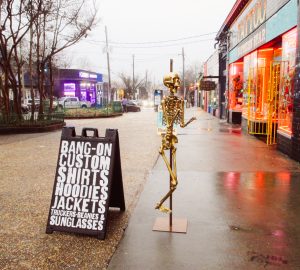Writer’s Corner: “Franken-Skirt: An Upcycling Horror Story” by Julia Wood
The Writer’s Corner features poetry, essays, short stories, satire and various fiction and non-fiction from SCAD Atlanta students. To submit your own work for the Writer’s Corner, email features@scadconnector.com.

The first thing I remember, after a long time of not remembering, is being brought into the light. Days had turned into weeks and weeks had turned into months of being smothered beneath a pile of other discarded garments. I had become so accustomed to the darkness surrounding me that I found comfort in it. There, I was able to daydream. I thought of an adopter, with a nice home that overlooked the park and impeccable fashion sense, who would hand wash me with care and wear me on their best nights. I wondered when this stylish angel would rescue me from my abode of rags and ripped trousers. But when I was finally yanked out of my bin, I met the devil incarnate.
She appeared sweet, dressed in hand-me-down jeans with floral stitching and a white crochet top that clung pleasantly to her frame. Her light brown hair was held up in every direction by bows and barrettes. She looked a little young to appreciate a classic vintage piece like myself. Nevertheless, I put my faith in her. “This is perfect,” she said, holding me up to the fluorescent bulbs. The bright lights — mixed with my nerves — made me nauseous, but I kept my emotions bottled up, awaiting my sanctuary. How naive I was.
When we arrived at a shabby little den downtown, I felt my heart racing. I could tell by peeping through the small holes in the canvas bag, where only a glimmer of light shone through, that I would not be enjoying my stay. Clothing was scattered across every inch of the apartment: bags on the coffee table, dresses thrown over the television set, shoes in the oven. If this is how she treats her clothes, I thought, then I’d have to find someone else to live with.
She placed her bag on a cluttered countertop and stuck her unmanicured hand inside, fumbling around and desperately trying to find me. She flicked a cherry-flavored tube of chapstick and an old gum wrapper in my direction and I nearly cried. I tried to make myself small, sucking my satin in, in hopes that she would give up, but to no avail. As she sunk her claws into me, I was freed from the dusty tote but caged, now, in a metal machine. Scalding hot water began to fill the tank, and as time passed, I struggled to stay afloat. The taste of chemicals engulfed my senses; I was drowning in sulfate and chlorine. I could feel the bleach stripping my skin and my fabric becoming looser. When I couldn’t stand it anymore, the spin cycle graciously pulled me under the soapy water and took me out of my misery as I blacked out, unable to handle the building pressure.
Unconsciousness was almost blissful until another burning sensation began to sear my fabric, jolting me back to life. Mist surrounded me, and I could barely see what new torture device I had been trapped in until the machine’s door swung open and a cool breeze momentarily relieved me.
That devil girl seized me again, with no delicacy in her fingertips, and threw me upon a stiff board. I nearly fainted once more as I saw the steaming iron clutched in her other pale hand. Without warning, she scorched me until I could no longer move. Agony crept up my hem and dispersed throughout my threads. I began to miss the darkness, the safety of my overpopulated bin. I wished now that it would consume me entirely. I cursed myself for wasting all my time daydreaming, jinxing my hopes into a nightmare.
As I lay on the table, I prayed to Dior that the torture would end. This can’t possibly get worse, I thought. But the real horrors were only beginning. She slashed me with scissors, slowly tearing my threads apart. I was fading away, falling in and out of consciousness. Sadistically, she worked, cutting me here and sewing me back up there, humming a soft tune all the while. It stopped for a moment, the pain, only long enough for her to grab some other poor garment, fraying and attaching its denim parts to my satin material. She stapled my sides and hot-glued baby pink and white ribbons to my front.
Droplets of the devil woman’s blood, from the tiny pricks of needles, had seeped into my material, creating pinkish stains along my ivory trim. I could hardly recognize what I had become. I looked nothing like what Ms. Chanel had originally intended. I was once the height of fashion following the First World War. Women would fight to get their hands on my smooth silk back then. Now, my fabric was stretched and rived and replaced with the miscellaneous pieces of other garments — like myself — who were torn from the safety of their thrift bins and maimed into monstrosities.
This can’t possibly get worse, I thought once more. But she paired me with polyester.





















